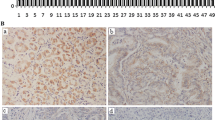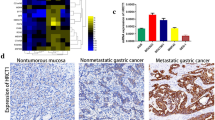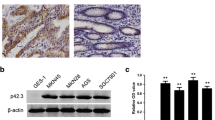Abstract
Altered signaling pathways or deregulated transcription factors represent an important category of molecular events leading to aberrant gene regulation in gastric cancer, among which the role of WNT/β-catenin pathway remains unclear. LRH-1 is a critical transcription factor in controlling cell proliferation via crosstalk with the β-catenin signaling pathway. In order to gain a knowledge of the expression of hLRH-1v1 and hLRH-1 in gastric cancer, a Q-PCR analysis was carried out. Our results showed that in about 50 and 47.6% of 42 tested patients with gastric cancer, the mRNA expression of hLRH-1v1 and hLRH-1 was significantly upregulated, as compared with self-paired normal control, respectively. Besides, overexpression of hLRH-1 was shown to promote the proliferation of gastric adenocarcinoma cell SGC-7901 via induction of cyclin E1. Taken together, our present study demonstrated for the first time the increased expression of hLRH-1v1 and hLRH-1 in human gastric cancer, an alteration which may implicate in tumorigenesis.





Similar content being viewed by others
Abbreviations
- LRH-1:
-
Liver receptor homolog 1
- RT:
-
Reverse transcription
- Q-PCR:
-
Real-time quantitative polymerase chain reaction
References
Wu M, Xue K (2004) Genetics of tumor. Scientific Press, Beijing, pp 409–435
Hanahan D, Weinberg RA (2000) The hallmarks of cancer. Cell 1000:57–70
Stock M, Otto F (2005) Gene deregulation in gastric cancer. Gene 360:1–19
Fayard E, Auwerx J, Schoonjans K (2004) LRH-1: an orphan nuclear receptor involved in development, metabolism and steroidogenesis. Trends Cell Biol 14:250–260
Luo Y, Liang CP, Tall AR (2001) The orphan nuclear receptor LRH-1 potentiates the sterol-mediated induction of the human CETP gene by liver X receptor. J Biol Chem 276:24767–24773
Schoonjans K, Annicotte J, Huby T et al (2002) Liver receptor homolog 1 controls the expression of the scavenger receptor class B type I. EMBO R 3:1181–1187
Goodwin B, Jones SA, Price RR et al (2000) A regulatory cascade of the nuclear receptors FXR, SHP-1, and LRH-1 represses bile acid biosynthesis. Mol Cell 6:517–526
Lu TT, Makishima M, Repa JJ et al (2000) Molecular basis for feedback regulation of bile acid synthesis by nuclear receptors. Mol Cell 6:507–515
Botrugno OA, Fayard E, Annicotte J et al (2004) Synergy between LRH-1 and β-catenin induces G1 cyclin-mediated cell proliferation. Mol Cell 15:499–509
Zhou J, Suzuki T, Kovacic A et al (2005) Interactions between prostaglandin E2, liver receptor homologue-1, and aromatase in breast cancer. Cancer Res 65:657–663
Annicotte JS, Chavey C, Servant N et al (2005) The nuclear receptor liver receptor homolog-1 is an estrogen receptor target gene. Oncogene 24:8167–8175
Schoonjans K, Dubuquoy L, Mebis J, et al (2005) Liver receptor homolog 1 contributes to intestinal tumor formation through effects on cell cycle and inflammation. Proc Natl Acad Sci USA 102:2058–2062
Nitta M, Ku S, Brown C et al (1999) CPF: an orphan nuclear receptor that regulates liver-specific expression of the human cholesterol 7α-hydroxylase gene. Proc Natl Acad Sci USA 96:6660–6665
Candidus S, Bischoff P, Becker KF et al (1996) No evidence for mutations in the alpha- and beta-catenin genes in human gastric and breast carcinomas. Cancer Res 56:49–52
Woo DK, Kim HS, Lee HS et al (2001) Altered expression and mutation of beta-catenin gene in gastric carcinomas and cell lines. Int J Cancer 95:108–113
Lee JH, Abraham SC, Kim HS et al (2002) Inverse relationship between APC gene mutation in gastric adenomas and development of adenocarcinoma. Am J Pathol 161:611–618
Abraham SC, Park SJ, Lee JH et al (2003) Genetic alterations in gastric adenomas of intestinal and foveolar phenotypes. Mod Path 16:786–795
Moon RT, Kohn AD, De Ferrari GV et al (2004) WNT and β-catenin signalling: diseases and therapies. Nat Rev 5:689–699
Morin PJ, Sparks AB, Korinek V et al (1997) Activation of β-catenin-Tcf signaling in colon cancer by mutations in β-catenin or APC. Science 275:1787–1790
Tetsu O, McCormick F (1999) β-Catenin regulates expression of cyclin D1 in colon carcinoma cells. Nature 398:422–426
He TC, Sparks AB, Rago C et al (1998) Identification of c-MYC as a target of the APC pathway. Science 281:1509–1512
Koh TJ, Bulitta CJ, Fleming JV et al (2000) Gastrin is a target of the beta-catenin/TCF-4 growth-signaling pathway in a model of intestinal polyposis. J Clin Invest 106:533–539
Yamada T, Takaoka AS, Naishiro Y et al (2000) Transactivation of the multidrug resistance 1 gene by T-cell factor 4/beta-catenin complex in early colorectal carcinogenesis. Cancer Res 60:4761–4766
Crawford HC, Fingleton BM, Rudolph-Owen LA et al (1999) The metalloproteinase matrilysin is a target of beta-catenin transactivation in intestinal tumors. Oncogene 18:2883–2891
Kolligs FT, Bommer G, Goke B et al (2002) Wnt/beta-catenin/tcf signaling: a critical pathway in gastrointestinal tumorigenesis. Digestion 66:131–144
Ebert MP, Fei M, Kahmann S et al (2002) Increased beta-catenin mRNA levels and mutational alterations of the APC and beta-catenin gene are present in intestinal-type gastric cancer. Carcinogenesis 23:87–91
Acknowledgments
We are grateful to Professor Jiliang Fu (Department of Medicine and Life Sciences, Tongji University, Shanghai 200092, China) and Zhimin He (Cancer Research Institute, Xiangya School of Medicine, Central South University, Changsha 410078, China) for their constructive comments of the manuscript.
Author information
Authors and Affiliations
Corresponding author
Additional information
Grants support: Grants 2004J067 from the Young Scientific and Technical Innovation Foundation of Fujian Province, C0710038 from the Natural Science Foundation of Fujian Province of China, and 200638 from the Foundation of Fuzhou Dongfang Hospital.
The authors Shui-Liang Wang and De-Zhu Zheng contributed equally to this work.
Rights and permissions
About this article
Cite this article
Wang, SL., Zheng, DZ., Lan, FH. et al. Increased expression of hLRH-1 in human gastric cancer and its implication in tumorigenesis. Mol Cell Biochem 308, 93–100 (2008). https://doi.org/10.1007/s11010-007-9616-1
Received:
Accepted:
Published:
Issue Date:
DOI: https://doi.org/10.1007/s11010-007-9616-1




